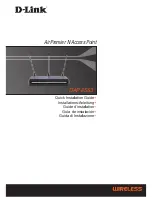
7
T
ERMINOLOGY
Access Point
—An internetworking device that seamlessly connects
wired and wireless networks.
Ad Hoc
—An ad hoc wireless LAN is a group of computers, each with
wireless adapters, connected as an independent wireless LAN.
Backbone
—The core infrastructure of a network. The portion of the
network that transports information from one central location to another
central location where it is unloaded onto a local system.
Base Station
—In mobile telecommunications, a base station is the
central radio transmitter/receiver that maintains communications with the
mobile radiotelephone sets within its range. In cellular and personal
communications applications, each cell or micro-cell has its own base
station; each base station in turn is interconnected with other cells’ bases.
BSS
—Basic Service Set. It is an access point and all the LAN PCs that are
associated with it.
CSMA/CA
—Carrier Sense Multiple Access with Collision Avoidance.
EAP
—Extensible Authentication Protocol, which provides a generalized
framework for several different authentication methods.
ESS
—Extended Service Set. More than one BSS is configured to become
an ESS. LAN mobile users can roam between different BSSs in an ESS
(ESS-ID, SSID).
Ethernet
—A popular local area data communications network, which
accepts transmission from computers and terminals.
Infrastructure
—An integrated wireless and wired LAN is called an
infrastructure configuration.
RADIUS
—Remote Access Dial-In User Server is an authentication method
used in conjunction with EAP for 802.1x authentication and session
based keys.
Roaming
—A wireless LAN mobile user moves around an ESS and
maintains a continuous connection to the infrastructure network.
RTS Threshold
—Transmitters contending for the medium may not be
aware of each other (they are “hidden nodes”). The RTS/CTS mechanism
can solve this problem. If the packet size is smaller than the preset RTS
Threshold size, the RTS/CTS mechanism will not be enabled.
Summary of Contents for 3CRWE876075 / WL-546
Page 6: ...6...
Page 14: ...1 6 CHAPTER 1 INTRODUCTION...
Page 40: ...3 12 CHAPTER 3 INITIAL CONFIGURATION...
Page 68: ...4 28 CHAPTER 4 SYSTEM CONFIGURATION Figure 32 WDS and Spanning Tree Settings...
Page 254: ...5 152 CHAPTER 5 COMMAND LINE INTERFACE...
Page 258: ...6 4 CHAPTER 6 TROUBLESHOOTING...








































